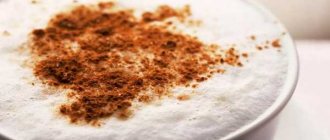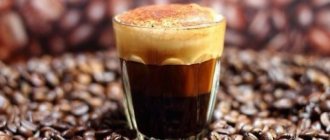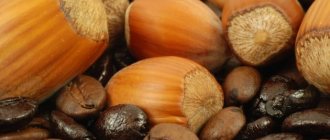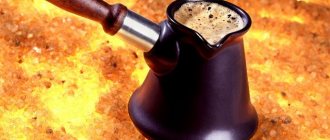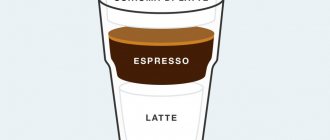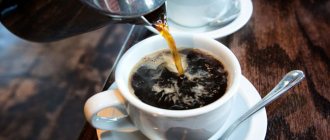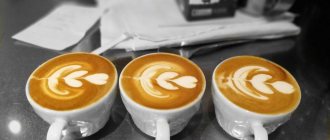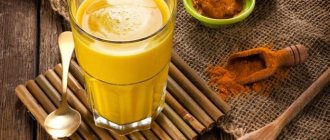If you ask for a latte in an Italian restaurant, the waiter will bring you a glass of milk (latte means “milk” in Italian). Coffee with milk, which in the rest of the world is shortened to simply “latte” (with the obligatory emphasis on the first syllable), is called café latte in Italian and nothing else.
Difference. The latte coffee drink is a mixture of coffee and milk with foam. When preparing a classic latte, milk is poured into the coffee. If you pour coffee into milk, you get a latte macchiato. Latte differs from its closest relative, cappuccino, in the proportions of ingredients (a much larger amount of milk) and relatively low milk foam.
The history of latte coffee
In Europe, it was customary to drink coffee with milk at the end of the 17th century. For example, the first written mention that Austrians like to mix these two products dates back to 1680. Later, the drink was transformed into the famous Viennese coffee, with a lush head of cream. In other countries, coffee was mixed with milk in arbitrary proportions, without giving the drink any special name. In Spain they still serve café con leche in small cups, in France – café au lait.
Italy had its own, very special coffee with milk - cappuccino. But in the 19th century, Europe and America were struck by the fashion for everything antique, and crowds of tourists poured into Italy. While Europeans got used to local coffee over time, even cappuccino seemed too strong to Americans, so in coffee shops they asked for more milk to be added to the drink.
Gradually a new recipe was born. Already in 1847, one of the English newspapers casually mentioned that in Italian coffee shops tourists were served coffee latte, which was less strong than traditional cappuccino. The drink was described in detail by the Englishman William Dean Howells, who published the essay “Italian Travels” in 1867.
However, Americans are still confident that the honor of inventing the classic latte proportions belongs to the Italian emigrant Lino Majorin, who owned the Mediterraneum bar in the Californian city of Berkeley in the 50s of the 20th century. Mr. Majorin used espresso as the base for his latte.
The real European boom in latte coffee began in the 80s of the 20th century and has not subsided to this day. The drink is truly loved by those for whom classic espresso seems too strong. Interestingly, in the USA and Canada, a passion for latte is equated with the desire to stand out from the crowd and demonstrate one’s elitism. American conservatives even pejoratively call their political opponents latte liberals.
Rules for making latte coffee
You don't need to be a gourmet to tell the difference between a latte and a cappuccino: latte is less strong in terms of caffeine content. To prepare a latte, mix 1 part black coffee with 2-3 parts milk. Most often, the basis for the drink is double espresso (50–60 ml). It is mixed with 100–180 ml of milk.
Latte is democratic: as a base you can use coffee of any strength, prepared in a Turk, French press, Aeropress, or any model of coffee maker.
Characteristics of latte coffee (table)
| Bean varieties | Any inexpensive mixture of several Arabica varieties, possibly adding up to 20% Robusta |
| Roasting degree | Medium: Full City or Viennese |
| Grinding | Fine or medium espresso |
| Coffee for the base | Espresso or any other black coffee prepared in a Turk, French press, geyser or drip coffee maker |
| Pressure in the coffee machine (if espresso is used as the base) | In the espresso chamber - at least 9 bar, pump operating pressure - at least 15 bar |
| Group water temperature (for espresso preparation) | From +91 to +93 °C |
| Coffee base temperature | +70 ± 5 °C |
| Frothed milk temperature | from +60 to +65 °C |
| Cooking time | 3–8 minutes, depending on coffee base (fastest for espresso) |
| Portion output volume, ml | 150–240 ml |
| Caffeine content (strength) | 100–136 mg (per double espresso shot) |
| Recommended intake (servings per day) | 1 |
| Maximum permissible norm (servings per day) | 3 |
| Calories without sugar | 58–68 kcal per 100 ml, depending on the fat content of the milk; 104–163 kcal per serving |
| Calories with sugar | 124–183 kcal - a serving of coffee with 5 g of sugar (1 sticker) |
Selection of coffee for latte
Milk smoothes out weak shades of coffee aroma, leaving only the strongest, slightly rough tones. Therefore, it makes no sense to prepare lattes from single-origin Arabica beans or expensive blends: milk will still hide the nuances of taste and the noble aftertaste of elite coffee.
For a latte, a mixture of Arabica with 10–20% Robusta is well suited: the bitterness, which seems excessive in black coffee, goes well with the creamy tenderness of milk.
Roasting and grinding beans
To make a latte, use medium or fine grind espresso coffee. Roasting beans darker than Vienna is not an acquired taste: many people consider the combination of milk and coffee made from darkly roasted beans unpleasant.
But to make a latte you don’t necessarily need freshly ground coffee. Both store-bought ground coffee and homemade coffee, ground even more than 2 weeks ago, are suitable. Ready-made coffee with flavors cannot be prepared in a carob coffee maker or Turk, but it can be prepared in a French press. However, you should consider in advance how flavoring additives will harmonize with milk. Additives with cinnamon, vanilla, and chocolate flavors are preferable.
Choice of water
Tap water, even boiled water, is not suitable for preparing coffee base: the taste of coffee deteriorates due to the high content of chlorine and its compounds. To purify such water, aquafilters or ozonizers are used. But the most preferable is spring, well or bottled water with a mineralization in the range of 70–200 mg/l (the optimal value is 150 mg/l).
The right milk for latte
The fat content of milk for lattes is the subject of endless debate among baristas of all nations. But most experts agree that milk with a fat content of more than 3.5% froths poorly, and if this figure is below 2%, the coffee loses its delicate creamy flavor and the foam seems too watery.
It has been experimentally established that the best fat content of milk for latte is 2.5–3.2%. Even those who adhere to a diet are not recommended to skimp on the fat content of milk: 10–25 kcal can be saved by reducing portions of other products, and the delicate taste of a properly prepared latte can charge you with optimism for the whole day.
The best choice is pasteurized milk. It is important not to overheat it, otherwise it will not be possible to make the latte tasty: at a temperature of +75 °C, protein compounds decompose, which worsens the taste of the drink.
Milk foam for latte should be homogeneous, without large bubbles, and have the consistency of cream. Baristas call this foam wet.
You can froth the milk with a mixer or using a cappuccino maker. In the first case, the milk must first be heated to a temperature of +60 °C.
But the best and fastest way is to froth the milk in a cappuccino maker. To do this, pasteurized milk, cooled to +4 °C, is poured into the pitcher. The liquid level should not be higher than the base of the spout (groove) of the container.
The easiest way to prepare milk is with a cappuccino maker
The steam generator nozzle is not located in the center, but closer to the edge of the vessel, and is immersed in the milk no more than 0.5 cm. When the device is turned on, the milk moves clockwise. As foam forms, the pitcher is lowered so that the steam tap nozzle is constantly at the boundary of liquid and air (0.5 cm below the foam level).
When the foam level is 3-4 fingers below the edge of the pitcher, the steam generator is deepened by lowering the nozzle to the bottom. Use one palm to support the bottom of the vessel and, when the hand becomes uncomfortable (that is, the milk heats up to +60 °C), the steam generator is turned off. If the foam settles while the coffee is brewing, the milk cannot be frothed again.
Variations on a theme
There are quite a lot of techniques for preparing a delicious treat originally from Italy, but even more variations exist in latte art. Drawings on milk foam can be very diverse. So on Valentine's Day, drinks are decorated with designs in the shape of a heart or angels, and on Christmas - with symbols of this holiday. You can write a declaration of love, or even a marriage proposal, on the foam. A professional barista, for whom latte art is more than a decoration for coffee, is able to create real paintings that are so beautiful that you don’t even want to destroy them.
In South African establishments you will be offered a red delicacy, that is, with rooibos, and in some European countries syrup (vanilla, chocolate or fruit) is added to the drink. But you should not use syrup from citrus fruits, otherwise the milk will spoil both the taste and appearance. By the way, in some countries they have moved away from the recipe and instead of hot milk they add cold milk, and even add pieces of crushed ice to the glass. This treat is called an iced drink. On the Internet you can find a wide variety of recipes for preparing this wonderful, tasty and very nutritious drink. By the way, about nutritional value, you shouldn’t get carried away with this delicacy if you’re on a diet. The number of calories per serving is quite impressive. Although, what kind of diet can we talk about when looking at this beauty? Well, in order to comprehend Italian art and learn how to create masterpieces of painting on milk foam, you will have to attend barista courses and hone your skills in practice. Return to content
Classic latte recipe
Ingredients:
- espresso (other black coffee) – 50-60 ml;
- fresh milk – 100-180 ml.
Cooking technology
- Whisk the milk.
- Prepare black coffee.
- Pour the coffee into an Irish coffee glass or ceramic cup.
- Pour milk in a thin stream. In this case, the liquids should mix, and a foam about 1 cm thick should form on the surface.
This is a basic latte recipe. It can be varied by mixing coffee with 10–20 ml of sweet syrup. To obtain vanilla flavor, milk is mixed with vanilla before whipping. The foam can be lightly sprinkled with cinnamon or chocolate chips.
Types of latte
Latte macchiato
Latte macchiato uses the same ingredients as a classic latte. Black coffee is brewed in the same way and milk is frothed. The milk is then poured into a glass for Irish coffee. Black coffee is poured into the frothed milk in a thin stream.
The specific gravity of coffee is less than that of milk, so the drink in the glass stratifies: the milk settles to the bottom, the coffee sits above it, and on top there is snow-white foam with a speck of coffee: translated from Italian, macchiato means “stained.” The effectiveness of the speck can be emphasized by sprinkling it with chocolate chips.
Ghetto latte
Black coffee and a glass of whipped milk are served separately. The guest himself selects the proportions of the ingredients.
How to serve and drink the drink correctly
The enjoyment of its taste depends on the elegance of serving the latte. To serve it in cafes and at home, special tall, heat-resistant Irish glasses are used, in addition to which comes a small spoon. With its help, foam is removed. Glasses allow the drink to stay warm longer, which affects its taste. When served correctly, the layers of the latte should be clearly visible.
It must be served immediately after preparation. This also affects its taste.
The latte is drunk slowly. This helps to capture all of its flavor notes. Many people like the unforgettable taste of latte. Anyone who tries the drink once becomes a constant admirer.
Rules for serving latte
Italians drink lattes exclusively in the morning. There are two main options for serving coffee latte and latte macchiato:
- in a tall transparent glass with a straw. However, some foodies argue that plastic ruins the taste of the latte;
- in a glass with a coffee spoon. If you gently stir the foam with it, the drink will acquire a particularly delicate texture. However, the guest will not violate etiquette if he first enjoys the foam with a spoon and then drinks the coffee.
A sugar bowl or sticker of sugar is served along with the latte. Coffee goes well with pastries, jellies, mousses, and desserts with mascarpone.
Ingredients
It is not customary to add sugar to a proper latte. It is believed that the lactose contained in milk breaks down when heated above 60 C and gives the drink the necessary sweetness. But if you like it sweeter, then a spoonful of granulated sugar won't hurt.
- Coffee beans/ground – 1 tbsp. l.;
- Purified water – 50 ml;
- Milk – 150 ml.
Note. You've probably noticed that in any cafeteria you can order a latte with skim milk. Unfortunately, for latte coffee at home, you are unlikely to be able to whip such a product until foamy - the power of a household mixer is not enough. Therefore, when purchasing ingredients, give preference to milk with a fat content of 3.2%. It's much easier to work with.
But if there are restrictions for milk, then you can take absolutely any coffee:
- In grains;
- Ground;
- Soluble.
It all depends on your taste preferences.
